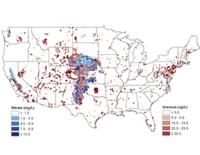Advertisement
Grab your lab coat. Let's get started
Welcome!
Welcome!
Create an account below to get 6 C&EN articles per month, receive newsletters and more - all free.
It seems this is your first time logging in online. Please enter the following information to continue.
As an ACS member you automatically get access to this site. All we need is few more details to create your reading experience.
Not you? Sign in with a different account.
Not you? Sign in with a different account.
ERROR 1
ERROR 1
ERROR 2
ERROR 2
ERROR 2
ERROR 2
ERROR 2
Password and Confirm password must match.
If you have an ACS member number, please enter it here so we can link this account to your membership. (optional)
ERROR 2
ACS values your privacy. By submitting your information, you are gaining access to C&EN and subscribing to our weekly newsletter. We use the information you provide to make your reading experience better, and we will never sell your data to third party members.
Environment
Road Salt Permeates Urban Streams
Water Pollution: Chloride in road deicers inevitably finds its way into nearby waters, at concentrations toxic for aquatic life
by Steven C. Powell
September 9, 2010

Deicing roads is essential during winter storms, but a new study in Environmental Science & Technology illustrates the damage that road salt inflicts downstream of its application (DOI: 10.1021/es101333u). After heavy snowfalls, many urban waters suffer from large doses of chloride that are lethal to aquatic life.
Scientists have studied the problems posed by road salt runoff since the 1960s, even as the amount of salt sold in the US for deicing has greatly increased, from 4 to 20 million tons per year from 1965 to 2005.
There are no national restrictions for applying salt to roadways, but in 1988 the EPA issued a report defining chronic and acute thresholds for chloride toxicity in streams and rivers. The nonbinding recommendations took into account a variety of aquatic species, and posited 230 and 860 mg/L as targets for maximum chloride concentrations in long- and short-term exposures, respectively.
A team of US Geological Survey (USGS) researchers based in Wisconsin set out to comprehensively assess the effects of road deicing on streams in Milwaukee and surrounding areas. Measuring electrical conductivity is a well-established proxy for determining chloride concentration. So the research team used an electrical-conductivity monitor that collects daily data in a local creek as a sentinel in the winter of 2007: When conductivity spiked, the scientists collected stream samples at 13 sites throughout the Milwaukee area and measured their chloride levels.
"The severity of chloride concentrations in the streams was much greater than we expected," says hydrologist Steve Corsi of the USGS's Wisconsin Water Science Center, lead author of the paper. More than half of the local streams had chloride levels that exceeded the EPA's recommended threshold; sometimes the effect even persisted through the summer. The researchers also found that the chloride-laced water samples were toxic to two endemic species—the fathead minnow and a water flea.
The researchers then used their highly detailed local data as a basis for analyzing the problem on a national level. They conclude that the severity of the problem in Milwaukee is representative of that in many cities in northern states. "There's some pretty serious water quality and potential aquatic toxicity problems in cities throughout the north," Corsi says.
Hydrologist John Mullaney, of the USGS's Connecticut Water Science Center, says that the data further clarify how urbanization affects waterways. "There are a lot of water quality impairments that we see in urban streams that have to be listed as 'cause unknown,'" he says, "and this chloride discharge is probably one of the contributors."





Join the conversation
Contact the reporter
Submit a Letter to the Editor for publication
Engage with us on Twitter